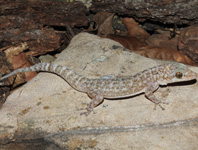Abstract
The concept of the thaerocytherid ostracod genus Neohornibrookella was established by Jellinek (1993) on valve and carapace specimens from Kenyan coastal waters, identified by him as belonging to the species Cythere lactea Brady, 1866. Thus, Jellinek (1993) nominated Cythere lactea as the type species for Neohornibrookella. However, he misidentified these Kenyan specimens, which are here interpreted to belong to the broadly distributed, thermophilic shallow marine species, Hermanites transoceanica Teeter, 1975. In accordance with Article 70.3 of the International Code of Zoological Nomenclature, 1999, either the species originally nominated as the type species (Cythere lactea Brady, 1866), or the species represented by the Kenyan specimens on which the genus was described (Hermanites transoceanica Teeter, 1975), may be accepted as the type species for Neohornibrookella Jellinek, 1993. In accordance with Article 70.3.2 of the International Code of Zoological Nomenclature, 1999 I choose Hermanites transoceanica Teeter, 1975 as the types species for Neohornibrookella Jellinek, 1993 because it conforms with the established concept of the carapace morphology for this genus, as per discussion below.
References
Benson, R. (1972) The Bradleya problem, with description of two new psychrospheric ostracode genera, Agrenocythere and Poseidonamicus (Ostracoda: Crustacea). Smithsonian Contributions to Paleobiology, 12, 1–138.
https://doi.org/10.5479/si.00810266.12.1Bonaduce, G. (1985) Bosasella, a new marine ostracode genus from Somalia. Bollettino della Società Paleontologica Italiana, 93, 1–9.
Bonaduce, G., Ruggieri, G. & Russo, A. (1984) The genus Tenedocythere (Ostracoda) of the Mediterranean Miocene to Recent especially from Italy. Bollettino della Società Paleontologica Italiana, 23 (3), 515–543.
Brady, G.S. (1866) On new or imperfectly known species of marine Ostracoda. Transactions of the Zoological Society, London, 5, 359–393.
https://doi.org/10.1111/j.1096-3642.1866.tb00649.xBrady, G.S. (1880) Report on the Ostracoda dredged by H.M.S. Challenger during the years 1873-1876. Report on the scientific results of the voyage of H.M.S. Challenger, Zoology, 1 (3), 1–184.
Cronin, T.M. (1988) Geographical isolation in marine species: evolution and speciation in Ostracoda, 1. In: Hanai, T., Ikeya, N. & Ishizaki, K. (Eds.), Evolutionary Biology of Ostracoda, its Fundamentals and Applications, Proceedings of the Ninth International Symposium on Ostracoda, Shizuoka, Japan, 29 July–2 August, 1985. Developments in Palaeontology and Stratigraphy 11. co-published Kodansha, Tokyo and Elsevier, Amsterdam, pp. 871–889.
https://doi.org/10.1016/S0920-5446(08)70227-9International Commission on Zoological Nomenclature (1999) International Code of Zoological Nomenclature. 4th Edition. The International Trust for Zoological Nomenclature, London, 306 pp.
Jellinek, T. (1993) Zur Ökologie und Systematik rezenter Ostracoden aus dem Bereich des kenianischen Barriere-Riffs. Senckenbergiana lethaea, 73 (1), 83–225.
Keyser, D. & Schöning, C. (2000) Holocene Ostracoda (Crustacea) from Bermuda. Senckenbergiana lethaea, 80, 567–591.
https://doi.org/10.1007/BF03043366Liebau, A. (1991) Skulptur-Evolution bei Ostrakoden am Beispiel europäischer “Quadracytheren”. Geologie und Paläontologie in Westfalen, 13, 1–404
Lienenklaus, E. (1896) Die Ostrakoden aus dem Miocaen von Ortenburg in Nieder-Baiern Collektion Egger. Sitzungsberichte der mathematisch-physikalische Classe der königlich bayerischen Akademie der Wissenschaften zu München, 26, 183–207.
Mostafawi, N. (2002) A revision of selected ostracod species from Uliczny 1969 (Pliocene; Cephalonia, Greece). Revista Española de Micropalaeontología, 34 (3), 315–330.
Mostafawi, N., Colin, J.-P. & Babinot, J.-F. (2005) An account on the taxonomy of ostracodes from recent reefal flat deposits in Bali, Indonesia. Revue de Micropaleontologie, 48, 123–140.
https://doi.org/10.1016/j.revmic.2004.12.001Teeter, J.W. (1973) Geographic distribution and dispersal of some recent shallow-water marine Ostracoda. Ohio Journal of Science, 73 (1), 46–54.
Teeter, J.W. (1975) Distribution of Holocene Marine Ostracoda from Belize. In: Wantland, K.F. & Pusey, W.C. (Eds.), Belize Shelf-Carbonate Sediments, Clastic Sediments, and Ecology. Studies in Geology 2. American Association of Petroleum Geologists, Tulsa, pp. 400–499.
Warne, M.T. & Whatley, R. (2016) Neohornibrookella sorrentae (Chapman and Crespin, 1928) and allied Neogene Ostracoda from southeastern Australia: systematic and palaeoceanographic relationships, palaeoecology and palaeobiogeography. Marine Micropaleontology, 125, 110–133.
https://doi.org/10.1016/j.marmicro.2016.04.003

